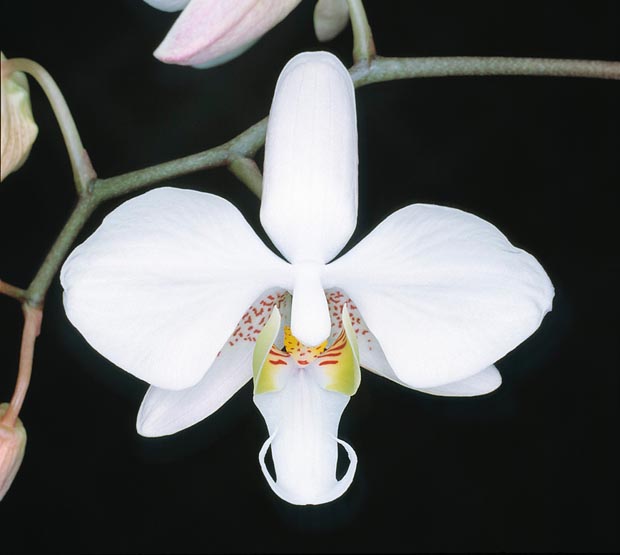Family : Orchidaceae

Text © Pietro Puccio

English translation by Mario Beltramini

Phalaenopsis x leucorrhoda is a natural hybrid between P. aphrodite and P. schilleriana © Giuseppe Mazza
The name of the genus is the combination of the Greek terms “phalaina” = butterfly and “opsis” = look, with obvious reference; the name of the hybrid is the combination of the Greek terms “leukόs” = white and “rhodόn” = pink, with reference to colour of the flowers.
The Phalaenopsis × leucorrhoda Rchb.f. (1875) is a well known natural hybrid between the Phalaenopsis aphrodite and the Phalaenopsis schilleriana with short stem entirely hidden by the imbricate foliar bases and fleshy leaves, distichous, almost elliptic, of green colour spotted of silvery grey in the upper page, uniformly purple below, 25-35 cm long and 8-12 cm broad.
Inflorescences about 70 cm long, usually hanging, carrying a variable number of flowers of 6-8 cm of diameter with sepals and petals from white, at times suffused with pink, to intense pink with paler margins, labellum with lateral lobes white or yellow, spotted of red and central lobe from white to purple with yellow and purple spots.
The sepals are ovate-elliptic, 2,5-3,5 cm long, the petals, from reniform to almost circular, are 2,5-4 cm long, the labellum is trilobed, 2,5-3 cm long, with lateral spatulate lobes and central lobe of variable shape with a fleshy excrescence (callus) at the base of bright yellow colour spotted of red and
two appendices at the extremity. It usually reproduces by micro-propagation.
Hybrid between two of the most ornamental species of the genus, it inherits from them the best characteristics, such as, for instance, the spottiness of the leaves from the Phalaenopsis schilleriana. It can be cultivated with the same modalities already described for this last.
→ For general notions about ORCHIDACEAE please click here.
